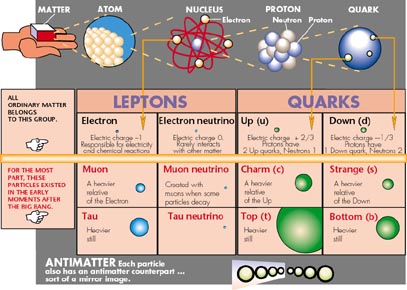| 1. The scientific basis of the CNGS project |
| 1.1
CERN and neutrino physicsCERN's purpose is to study the
foundations of the structure of matter. Its sphere of activity is high energy physics,
also known as elementary particle physics.
Specifically, CERN designs, builds and operates high-energy accelerators and detectors, which are the tools needed for its research. Together with thousands of scientists from across the world studying the sub-microscopic make-up of matter and the fundamental forces, CERN has contributed much to the development of what we know as the standard model. |
| Figure 1: The standard model |
| The standard model explains the composition of ordinary matter, that is atoms and
their constituents: the electron, a fundamental particle, the proton and the neutron, both
consisting of three elementary particles, called quarks. Moreover, the standard model
contains all the necessary ingredients for explaining on the one hand particles discovered
in the cosmic rays and, on the other, the particles produced by accelerators, which were
also present in the Universe during the first few minutes after its birth in "the Big
Bang".
Neutrinos are the hardest of the sub-atomic particles to study. They are produced by the decay of other particles, for example neutrons in a radioactive nucleus:
|
